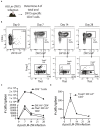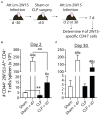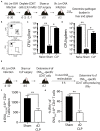Polymicrobial Sepsis Impairs Antigen-Specific Memory CD4 T Cell-Mediated Immunity
- PMID: 32903436
- PMCID: PMC7435018
- DOI: 10.3389/fimmu.2020.01786
Polymicrobial Sepsis Impairs Antigen-Specific Memory CD4 T Cell-Mediated Immunity
Abstract
Patients who survive sepsis display prolonged immune dysfunction and heightened risk of secondary infection. CD4 T cells support a variety of cells required for protective immunity, and perturbations to the CD4 T cell compartment can decrease overall immune system fitness. Using the cecal ligation and puncture (CLP) mouse model of sepsis, we investigated the impact of sepsis on endogenous Ag-specific memory CD4 T cells generated in C57BL/6 (B6) mice infected with attenuated Listeria monocytogenes (Lm) expressing the I-Ab-restricted 2W1S epitope (Lm-2W). The number of 2W1S-specific memory CD4 T cells was significantly reduced on day 2 after sepsis induction, but recovered by day 14. In contrast to the transient numerical change, the 2W1S-specific memory CD4 T cells displayed prolonged functional impairment after sepsis, evidenced by a reduced recall response (proliferation and effector cytokine production) after restimulation with cognate Ag. To define the extent to which the observed functional impairments in the memory CD4 T cells impacts protection to secondary infection, B6 mice were infected with attenuated Salmonella enterica-2W (Se-2W) 30 days before sham or CLP surgery, and then challenged with virulent Se-2W after surgery. Pathogen burden was significantly higher in the CLP-treated mice compared to shams. Similar reductions in functional capacity and protection were noted for the endogenous OVA323-specific memory CD4 T cell population in sepsis survivors upon Lm-OVA challenge. Our data collectively show CLP-induced sepsis alters the number and function of Ag-specific memory CD4 T cells, which contributes (in part) to the characteristic long-lasting immunoparalysis seen after sepsis.
Keywords: CD4 T cells; IFN-gamma; immune suppression; memory; sepsis.
Copyright © 2020 Sjaastad, Kucaba, Dileepan, Swanson, Dail, Cabrera-Perez, Murphy, Badovinac and Griffith.
Figures







Similar articles
-
Polymicrobial Sepsis Chronic Immunoparalysis Is Defined by Diminished Ag-Specific T Cell-Dependent B Cell Responses.Front Immunol. 2018 Oct 31;9:2532. doi: 10.3389/fimmu.2018.02532. eCollection 2018. Front Immunol. 2018. PMID: 30429857 Free PMC article.
-
CD4 T Follicular Helper Cells Prevent Depletion of Follicular B Cells in Response to Cecal Ligation and Puncture.Front Immunol. 2020 Aug 12;11:1946. doi: 10.3389/fimmu.2020.01946. eCollection 2020. Front Immunol. 2020. PMID: 32903485 Free PMC article.
-
Gut Microbial Membership Modulates CD4 T Cell Reconstitution and Function after Sepsis.J Immunol. 2016 Sep 1;197(5):1692-8. doi: 10.4049/jimmunol.1600940. Epub 2016 Jul 22. J Immunol. 2016. PMID: 27448587 Free PMC article.
-
CD4 T Cell Responses and the Sepsis-Induced Immunoparalysis State.Front Immunol. 2020 Jul 7;11:1364. doi: 10.3389/fimmu.2020.01364. eCollection 2020. Front Immunol. 2020. PMID: 32733454 Free PMC article. Review.
-
Listeria monocytogenes: a model pathogen to study antigen-specific memory CD8 T cell responses.Semin Immunopathol. 2015 May;37(3):301-10. doi: 10.1007/s00281-015-0477-5. Epub 2015 Apr 10. Semin Immunopathol. 2015. PMID: 25860798 Free PMC article. Review.
Cited by
-
Efficacy of ganciclovir in the treatment of cytomegalovirus (CMV) infection in infants and its effect on inflammatory reaction and immune function.Am J Transl Res. 2023 Nov 15;15(11):6514-6523. eCollection 2023. Am J Transl Res. 2023. PMID: 38074833 Free PMC article.
-
Regulatory effect of Pseudomonas aeruginosa mannose-sensitive hemagglutinin on inflammation and immune function in percutaneous nephrolithotomy patients with upper urinary tract calculi complicated with infection.Front Immunol. 2023 Jun 12;14:1181688. doi: 10.3389/fimmu.2023.1181688. eCollection 2023. Front Immunol. 2023. PMID: 37377966 Free PMC article.
-
Identification and validation of m6A RNA methylation and ferroptosis-related biomarkers in sepsis: transcriptome combined with single-cell RNA sequencing.Front Immunol. 2025 Mar 7;16:1543517. doi: 10.3389/fimmu.2025.1543517. eCollection 2025. Front Immunol. 2025. PMID: 40124361 Free PMC article.
-
Embracing the heterogeneity of natural viruses in mouse studies.J Gen Virol. 2022 Jun;103(6):001758. doi: 10.1099/jgv.0.001758. J Gen Virol. 2022. PMID: 35737518 Free PMC article.
-
Severity of Sepsis Determines the Degree of Impairment Observed in Circulatory and Tissue-Resident Memory CD8 T Cell Populations.J Immunol. 2021 Oct 1;207(7):1871-1881. doi: 10.4049/jimmunol.2001142. Epub 2021 Sep 3. J Immunol. 2021. PMID: 34479943 Free PMC article.
References
-
- Shankar-Hari M, Phillips GS, Levy ML, Seymour CW, Liu VX, Deutschman CS, et al. Developing a new definition and assessing new clinical criteria for septic shock: for the third international consensus definitions for sepsis and septic shock (Sepsis-3). JAMA. (2016) 315:775–87. 10.1001/jama.2016.0289 - DOI - PMC - PubMed
-
- Brun-Buisson C, Doyon F, Carlet J, Dellamonica P, Gouin F, Lepoutre A, et al. . Incidence, risk factors, and outcome of severe sepsis and septic shock in adults. A multicenter prospective study in intensive care units French ICU Group for Severe Sepsis. JAMA. (1995) 274:968–74. 10.1001/jama.1995.03530120060042 - DOI - PubMed
Publication types
MeSH terms
Substances
Grants and funding
LinkOut - more resources
Full Text Sources
Medical
Molecular Biology Databases
Research Materials
Miscellaneous

